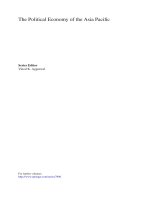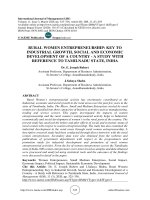Economic growth and economic development 380
Bạn đang xem bản rút gọn của tài liệu. Xem và tải ngay bản đầy đủ của tài liệu tại đây (98.44 KB, 1 trang )
Introduction to Modern Economic Growth
(1) Show that W (x (t) , y (t)) can be written as
Z t1 h
i
H (t, x (t) , y (t)) + λ˙ (t) x (t) dt − λ (t1 ) x (t1 ) + λ (0) x0 ,
W (x (t) , y (t)) =
0
where H (t, x, y) ≡ f (t, x (t) , y (t)) + λ (t) g (t, x (t) , y (t)) is the Hamilton-
ian and λ (t) is the costate variable.
(2) Now suppose that the pair (ˆ
x (t) , yˆ (t)) together with terminal date tˆ1 constitutes an optimal solution. Consider the following class of variations
y (t) = yˆ (t) + εη (t) and t1 = tˆ1 + ε∆t.
Denote the corresponding path of the state variable by
¢
¡
x (t, ε) = xˆ (t) + εσ (t) and x tˆ1 + ε∆t, ε = xˆ (t1 ) + ε∆x
for some σ (t) and ∆x. Evaluate W (x (t) , y (t)) at this variation. Explain
why this variation is feasible for ε small enough.
(3) Show that for a feasible variation,
¯
Z tˆ1 h
i
dW (x (t) , y (t)) ¯¯
˙
Hx (t, x (t) , y (t)) + λ (t) σ (t) dt
=
¯
dε
0
ε=0
Z tˆ1
Hy (t, x (t) , y (t)) η (t) dt
+
0
¡
¡ ¢ ¡ ¢¢
¡ ¢
+H tˆ1 , x tˆ1 , y tˆ1 ∆t − λ tˆ1 ∆x.
(4) Explain why the previous expression has to be equal to 0.
(5) Now taking the limit as tˆ1 → ∞, derive the weaker form of the transversality
condition (7.44).
(6) What are the advantages and disadvantages of this method of derivation
relative to that used in the proof of Theorem 7.13.
Exercise 7.15. * Consider the following maximization problem:
Z 1
f (x (t) , y (t)) dt
max
x(t),y(t)
0
subject to
x˙ (t) = y (t)2
366









